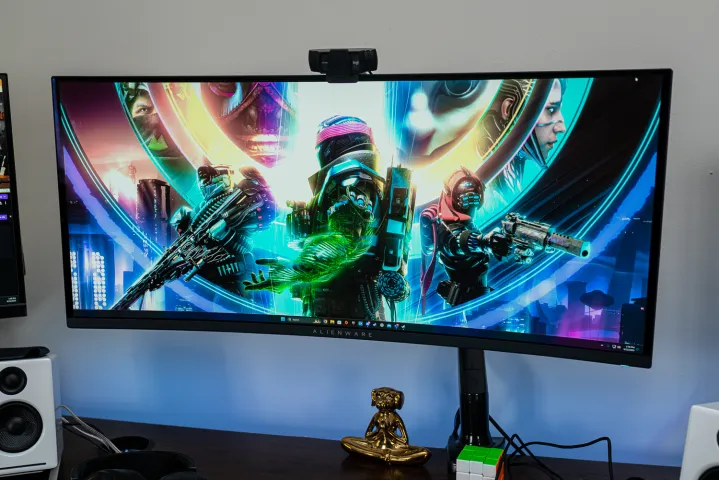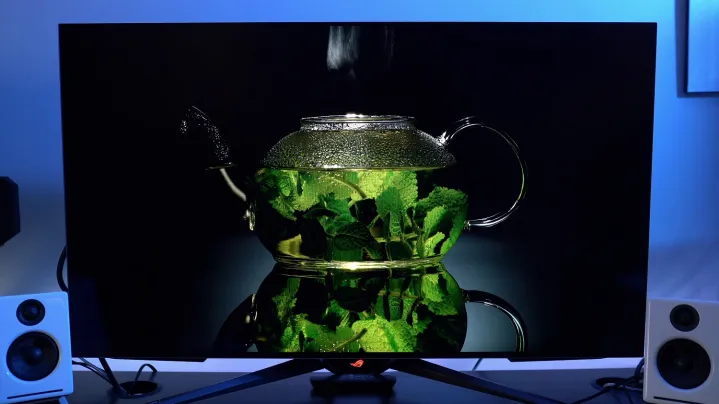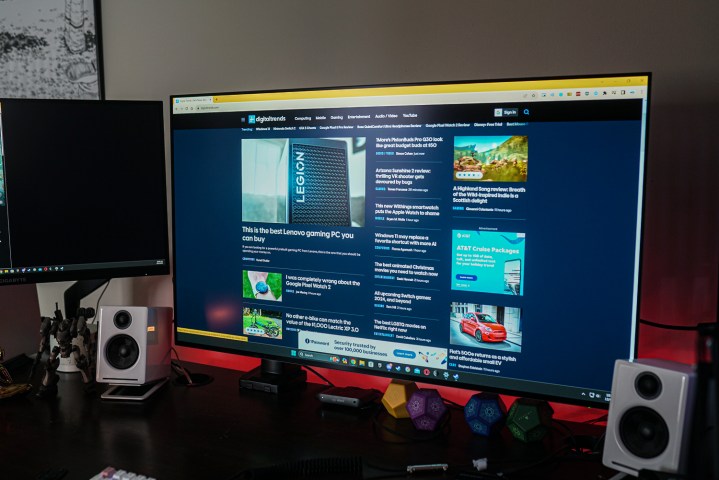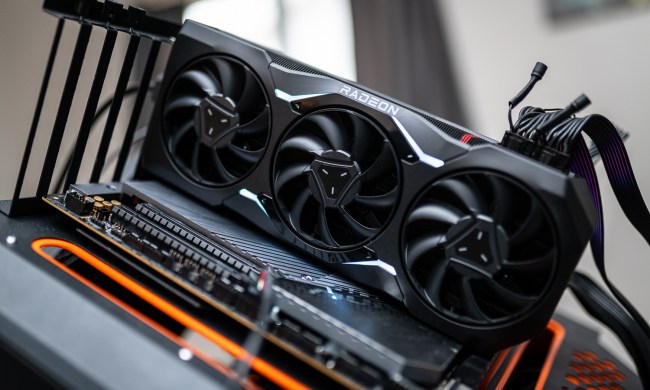
Call me insane, but I traded the best gaming monitor money can buy.
I’m talking about the Alienware 34 QD-OLED, of course, which I bought about a year ago. I’ve been in love with it ever since, immediately recognizing why it’s widely considered one of the most important gaming monitors released in the last few years. The most recent holiday barrage of deals got me, though, and I sold the monitor, which often tops lists and review charts, in exchange for something completely different.
I picked up the KTC G42P5. I understand if you don’t know who KTC is — I didn’t, either — but I rolled the dice on the display after I found an Amazon deal that was too good to pass up. I’ve had the monitor for about a week now, and I’ve already put it through its paces. And I’m floored.
Hitting the right price

Let’s start with why I chose this particular monitor, though. It’s a 42-inch OLED display, which, yes, I recognize sounds like a massive size for a computer monitor. It is, but I’m certainly not the first one to put a 42-inch display in front of my PC. And in practice, a 42-inch 16:9 monitor is a lot closer in size to a 34-inch 21:9 monitor like the Alienware 34 QD-OLED than it sounds.
There are several reasons I wanted to switch back to 16:9. I wanted to be able to play console games on my main display without black bars, and I wanted to be able to take 4K screenshots for the performance guides I write here on Digital Trends. More than anything, though, I was just done messing around with the problems 21:9 brings.
The Alienware 34 QD-OLED is great, but I was fed up with playing Elden Ring with black bars or getting sucked out of Alan Wake 2 whenever a cutscene played. At the same time, I didn’t want to give up the perfect black levels of OLED or the massive screen real estate the Alienware 34 QD-OLED offered me. The KTC G42P5 checked all of my boxes, and at a price I could actually justify.

There are a few other options if you’re interested in this form factor. It uses an LG OLED panel, so naturally, you could pick up the 42-inch LG C3 OLED. There are a couple of problems compared to KTC, though. For starters, it’s a TV, so it lacks DisplayPort, and it’s more expensive. I spent $800 on the KTC display, while the LG TV sells for $1,000, or $900 on sale. The LG has some upsides like image processing if you’re not worried about latency, but that didn’t tip the scales for me.
The main competition is the Asus ROG Swift PG42UQ. It’s a 42-inch monitor just like the KTC, and it’s overclocked to 138Hz (also just like the KTC). It’s a near-perfect monitor, but there’s one big problem. It’s $1,400. Even during holiday sales, I’ve never seen it sell for cheaper than $1,200 — that’s a full $400 more than what I spent on the KTC for what is essentially the same display.

Those are your only two options if you want this form factor. Older LG TVs like the C2 OLED are available, but for above $1,000, and the Gigabyte Aorus FV43U is cheaper, but it’s not OLED. I picked up the KTC G42P5 on sale for $800, but even now, it’s available for $1,000 at the time of writing. That’s still $400 cheaper than the Asus display at list price.
The natural question is, why? If this is the same panel with the same features, why is it so much cheaper than the competition? There are actually a couple of reasons.
Why is it cheaper?

I’ll assume you’ve never heard of KTC. It’s a Chinese company that started pushing out displays in 2021, and the brand has only recently started making the rounds on Amazon. KTC as a company, though, isn’t new. KTC says it’s been around for 27 years, serving as a manufacturer of displays for companies like Samsung, ViewSonic, and LG. You probably haven’t seen a KTC-branded monitor, but there’s a decent chance you actually have seen a KTC monitor.
The idea here is that the middleman is becoming the seller with KTC, which pushes down prices a little bit. That’s not a crazy idea in the world of tech. Even AMD, Intel’s biggest competitor in the world of processors, started out as a supplier for Intel before breaking off into its own standalone brand.
There’s a practical reason for this particular monitor being cheaper than the competition as well: It doesn’t include a stand. It’s easy to forget how expensive a solid stand for a 42-inch display can be — $125, at least for KTC’s G42P5 stand — and KTC cuts that cost out.

That could be a downside depending on what you’re wanting to do with the display. For me, it was a positive. I was able to save some money because I already had a monitor arm — about $50 on Amazon — and for a display this large, there’s a good chance you’re going to mount it on your wall. There are also TV stands available for the 100 x 100 VESA mount for about $15. Regardless, there are several situations with a display this large where you might not use the included stand, and at least you have the option to skip it with the KTC G42P5.
It’s worth noting that, even with the stand, the G42P5 comes in $200 cheaper than the ROG PG42UQ, so the savings aren’t only reliant on the stand.
The monitor itself

Now, we need to talk about the monitor itself. The KTC G42P5 uses an LG OLED RGBW panel, which is the same panel in later versions of the LG C2. All of that is to say, it looks great. OLED offers perfect black levels for infinite contrast, while brightness, although low compared to LCD, is still enough to overcome most ambient lighting conditions.
Digging into the numbers, I measured brightness at around 400 nits for 10% of the screen in SDR, and that shot up to above 600 nits for a 3% windows in HDR. Those numbers don’t sound high, but remember that this is a 42-inch screen. You don’t want it blasting 1,000 nits at you as a computer monitor.
In practice, I have two windows directly pouring light into my office, and I’ve never struggled with brightness issues, and that’s while running the panel at 30% of its maximum. Unless you have extremely bright ambient lighting conditions, the brightness of the monitor shouldn’t be an issue.
For colors, this OLED panel offers a wide gamut. That means it exceeds 100% of the sRGB gamut, pushing into wider gamut like DCI-P3. In that color space, I measured an excellent 97%.
Color accuracy was a different matter. KTC calibrates each monitor at the factory and includes a report, but the calibration is off, specifically for the DCI-P3 and Adobe RGB color modes. I measured a color error of 6 for Adobe RGB and 4 for DCI-P3, neither of which is great. On the standard mode, the color error was over 3. Ideally, you want to see a color error of under 2.
That’s nothing a little calibration can’t fix. Using the free DisplayCal, I calibrated the monitor, and it was able to achieve a color error of 0.6, which is very good.
It’s always nice when colors are perfect out of the box, but at least you can pull the KTC back if you need great color accuracy. That doesn’t always matter in practice, though. Sure, the colors were off out of the box, but the display still looked great for games and movies before calibration.
Some downsides

There are some downsides here. For starters, the OSD (on-screen display) isn’t great. All of the options are there, but it looks a little janky. For instance, “overclock” is “over clock” in the menu, and some settings just randomly don’t capitalize letters. None of this actually matters for the performance of the monitor, but it certainly makes it feel like you’re getting a cheaper product.
The bigger issue is the Auto-Brightness Limiter (ABL). If you’re unfamiliar, all OLED displays have an ABL that limits the brightness when you reach certain thresholds. In practice, this plays out as the monitor quickly dimming itself when you pull up something very bright like a white webpage, and it gets brighter when you pull up something darker, such as a website in dark mode.
Ideally, ABL should be invisible on a display as it was on my Alienware 34 QD-OLED, but it’s very aggressive on the G42P5. I constantly see the display light up and limit itself as I’m swapping between browser tabs. It’s particularly annoying when I pull up the Windows search bar with a website open, as the screen immediately lights up with my dark mode Windows theme.
This would normally be a deal-breaker, but there are a couple of reasons it’s not for me. First, it only applies with
Second, it’s never become an issue in games or movies. There are situations where ABL can kick in and become distracting in media, but it’s not common enough to become a problem. Based on my testing, it looks like ABL kicks in when about 60% of the screen is white, dimming to its lowest point when pure white reaches about 70% of the screen. It’s not enough to turn me off of the G42P5, but it’s my biggest complaint coming from the Alienware 34 QD-OLED.
The final issue is the OLED maintenance feature, but it’s more of an annoyance than a problem. It kicks in automatically, giving you a 20-second countdown before the pixel refresh starts. This has already caught me a couple of times, locking me out of using my PC for a few minutes. Thankfully, you can turn off the automatic pixel refresh if you want.
Trading the best

The KTC G42P5 is a perfect answer for me. As much as I loved the Alienware 34 QD-OLED, I’ve been feeling the squeeze of 21:9 for a while, but I couldn’t justify spending $1,400 on the PG42UQ or over $1,000 on a 42-inch OLED from LG. The KTC G42P5 hit the right price with the right features, and with little in the way of sacrifices.
It’s not as seamless as the Alienware 34 QD-OLED, with disappointing color accuracy out of the box and annoying ABL in




